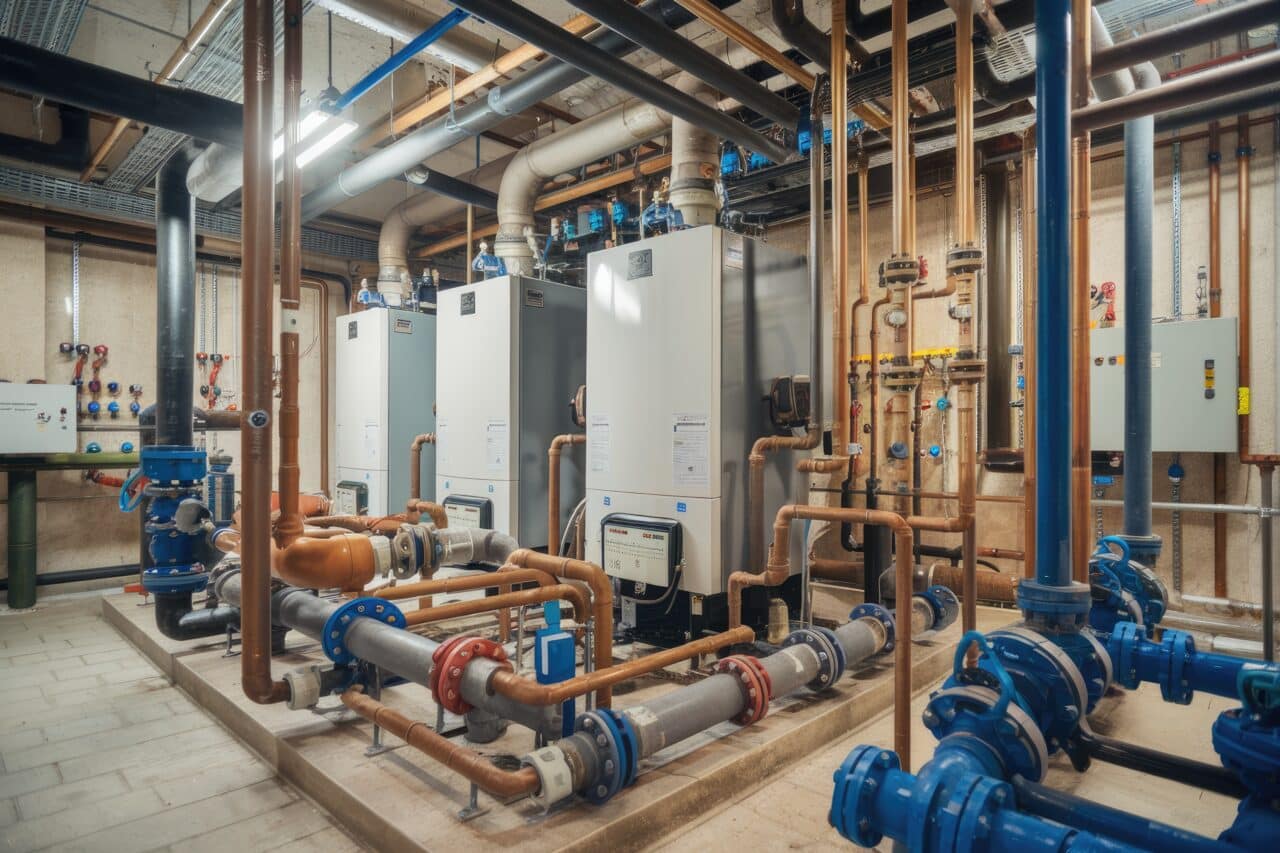Plumbing is one of the most critical yet often overlooked systems in a commercial facility. When things go wrong, they can go wrong fast—leading to costly repairs, operational downtime, and even health hazards. A small leak or slow drain might not seem like a big deal today, but if left unchecked, these minor issues can escalate into major disruptions.
Proactive plumbing maintenance can prevent these problems, saving your business time, money, and unnecessary stress. In this article, we’ll cover the key warning signs that indicate your plumbing system needs attention, the risks of delaying maintenance, and the benefits of scheduling a professional check-up before small issues become costly emergencies.
Why Commercial Plumbing Maintenance Matters
Your plumbing system is constantly in use, whether it’s supplying water for heating and cooling systems, facilitating restrooms and kitchens, or maintaining industrial operations. Over time, normal wear and tear, sediment buildup, and hidden leaks can impact performance, leading to inefficiencies and failures.
Unlike residential plumbing, commercial systems experience heavier usage, meaning problems can develop faster and have a more significant impact. A sudden pipe failure or water heater malfunction in a commercial building doesn’t just inconvenience a few people—it can halt business operations, disrupt customers, and lead to expensive property damage.
Regular plumbing inspections help businesses stay ahead of issues by identifying potential weak points before they escalate. Investing in preventative maintenance not only protects your facility but also improves efficiency, reduces water waste, and extends the lifespan of critical plumbing components.
Signs Your Plumbing System Needs Attention
It’s easy to ignore minor plumbing issues, but early detection is the key to avoiding costly repairs. Here are the most common signs that your plumbing system may need a professional check-up:
1. Unusual Water Pressure Fluctuations
Have you noticed a sudden drop or surge in water pressure? Low water pressure can indicate clogged pipes, leaks, or problems with the municipal water supply. On the other hand, excessively high water pressure can put undue stress on your pipes, increasing the risk of bursts or joint failures.
Pressure fluctuations may also be a sign of hidden leaks, which can lead to extensive water damage behind walls, in ceilings, or under floors. If your water pressure is inconsistent, it’s time for a professional inspection.
2. Persistent Drips and Unexplained Puddles
A slow, steady drip from a faucet or an unexpected puddle near sinks, toilets, or appliances may not seem like a major concern—but even minor leaks can lead to significant water waste and structural damage over time.
According to the U.S. Environmental Protection Agency (EPA), a single dripping faucet can waste more than 3,000 gallons of water per year. Not only does this increase your utility costs, but it also contributes to environmental waste. Worse, undetected leaks behind walls or under floors can create ideal conditions for mold growth, compromising air quality and posing health risks to employees and customers.
3. Inconsistent Water Temperature
If your facility’s hot water supply is unreliable—fluctuating between scalding hot and lukewarm—it’s a sign that your water heater may need servicing. Sediment buildup, failing heating elements, or a malfunctioning thermostat can all affect performance, leading to increased energy consumption and insufficient hot water.
Commercial water heaters work harder than residential units, making regular maintenance essential. Addressing temperature inconsistencies early can prevent complete system failure, extend the lifespan of your water heater, and reduce energy costs.
4. Slow or Frequently Clogged Drains
A slow drain is more than an inconvenience—it’s a warning sign of a developing blockage. Grease, soap scum, food particles, and other debris can accumulate in pipes over time, restricting water flow and increasing the risk of backups.
If multiple drains in your facility are experiencing slow drainage at the same time, you may have a more serious issue, such as a blocked sewer line. Left unchecked, sewer line problems can lead to costly repairs, foul odors, and even sanitation hazards.
5. Unpleasant Odors Coming from Drains
Foul smells coming from your drains could indicate a buildup of organic matter, stagnant water, or even a sewer gas leak. Sewer odors are more than just unpleasant—they can be a sign of a cracked pipe or improper venting, both of which need immediate attention.
If you notice persistent odors in restrooms, kitchens, or utility rooms, a professional plumber can inspect and clean your drainage system to prevent further issues.
6. Discolored or Rusty Water
If your water has a brownish or yellowish tint, it could be a sign of rust in your pipes or water heater. Corroded pipes can lead to leaks, reduced water quality, and potential health risks.
Discoloration may also indicate sediment buildup in your water heater, which can affect efficiency and shorten its lifespan. If you notice unusual water color changes, schedule a professional assessment to determine the root cause.
The Hidden Costs of Ignoring Plumbing Issues
Delaying plumbing maintenance can lead to significant financial and operational consequences:
- Higher Repair Costs: A minor leak today can turn into a burst pipe tomorrow, leading to expensive emergency repairs and water damage restoration.
- Increased Water Bills: Even small leaks can waste thousands of gallons of water annually, driving up utility costs.
- Business Downtime: A plumbing failure can disrupt operations, leading to lost revenue and frustrated customers or employees.
- Health and Safety Hazards: Leaking pipes and stagnant water can contribute to mold growth, bacterial contamination, and slip-and-fall risks.
Taking a proactive approach to plumbing maintenance helps businesses avoid these costly setbacks and ensures a smooth, efficient operation.
How Lee Company Can Help
At Lee Company, we specialize in comprehensive plumbing maintenance and repair services for commercial facilities. Our experienced team provides preventative solutions that help businesses avoid unexpected plumbing failures and reduce long-term costs.
Our Preventative Plumbing Services Include:
✅ Comprehensive Pipe Inspections – Identify weaknesses before they lead to leaks or failures.
✅ Leak Detection and Repair – Prevent water waste and structural damage.
✅ Water Heater Servicing – Ensure optimal performance and energy efficiency.
✅ Drain Cleaning and Clog Removal – Remove buildup and prevent costly backups.
✅ Backflow Prevention Testing – Protect your facility from backflow water contamination.
We understand the unique demands of commercial plumbing systems and tailor our maintenance plans to suit your facility’s needs.
Prepare for Seasonal Changes with a Plumbing Check-Up
Spring is the perfect time to schedule a plumbing inspection. As temperatures rise, increased water usage and pressure fluctuations can expose hidden weaknesses in your system. A professional check-up ensures that your facility is prepared for peak water demand in the summer months, reducing the risk of unexpected failures.
Whether you manage an office building, manufacturing plant, healthcare facility, or retail space, preventative plumbing maintenance is a smart investment that protects your property, employees, and bottom line.
Don’t Wait for a Plumbing Emergency – Schedule Your Check-Up Today
If your facility is experiencing any of the warning signs mentioned above, don’t wait for a costly breakdown to take action. A professional plumbing inspection can identify small problems before they escalate, helping you maintain efficiency, reduce expenses, and ensure business continuity.
By staying proactive with plumbing maintenance, businesses can avoid disruptions, reduce costs, and ensure their facilities remain safe and efficient. Don’t wait until it’s too late—schedule your plumbing check-up today.
Schedule your facility plumbing check-up today!
CALL US NOW AT 615.567.1000

